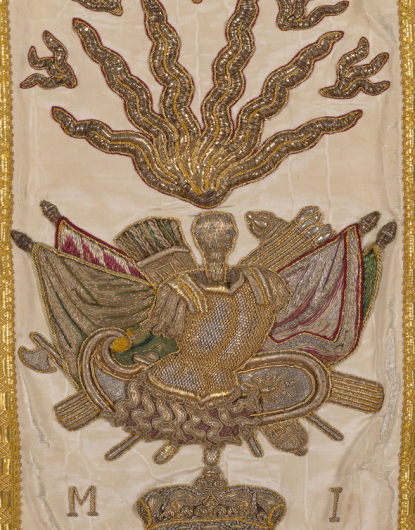Gifts from the Sun King
The celebratory presentation of the Order of the Holy Spirit to King John III Sobieski
On view in the State Rooms, May 19 – August 27, 2023
On view in the State Rooms, May 19 – August 27, 2023
John III Sobieski (b. 1629- d.1696) was already recognized as the leader of the pro-French party of the Polish-Lithuanian Commonwealth when he was elected king in 1674. In December 1675, Louis XIV of France invested him with the most prestigious French decoration granted to political allies – the Order of the Holy Spirit. Sobieski’s decoration ceremony took place at the church in Żółkiew (now Zhovkva, Belarus), his hereditary estate, on November 30, 1676. It was presided over the Bishop of Marseilles, Toussaint Forbin de Janson (acting as proxy for Louis XIV, the Grand Master of the Order), and the French envoy Marquis François Gaston de Béthune.
The Order of Holy Spirit was founded by Henri III (Valois), king of France and ephemeral king of Poland. In its statue of 1578, the king codified the vestments of the knights of the order and the details of the investment ceremony. He also commissioned the liturgical objects and vestments for the Order’s chapel at the church of the Grands Augustins in Paris. The chapel was destroyed during the French Revolution, but its furnishings miraculously survived and are now in the Louvre.
Until recently, the only analogy to the set of paraments from the Paris chapel are the pieces from Sobieski’s ”Order chamber” that Louis XIV had sent to Żółkiew in 1676 to provide the appropriate context for the ceremony. All of the textiles in the ensemble were covered with the emblems of the Order (the letter ”H”, the Valois fleur-de-lys, flames, and panoplies) executed in gold and silver thread. They were made by the same workshops that created Sobieski’s Order mantle – a masterpiece of Baroque-era embroidery. In 1983, Wawel Royal Castle curators discovered a small set of liturgical vestments bearing these symbols in the parish church in Pilica. They have been given to the church by Maria Sobieska née Wessel (1685-1761), the wife of Konstanty Władysław, King John III’s youngest son and the heir of Żółkiew. Forced to leave the Sobieski residence after her husband’s death in 1726, Maria took the priceless textiles from the Żółkiew chapel with her. Lined with new background fabrics and furnished with her coat of arms, she donated them to the church in Pilica, where she settled after 1731. Preserved in the Pilica parish were, in addition to the converted paraments, a cope and antependium donated by Karol and Pelagia Brzozowski in about 1890-1894, in which other elements of the furnishings of the French ”Order chapel” had been repurposed.
This unique find from years ago is now recalled in connection with the new display of Sobieski’s mantle in the Crown Treasury which reopened in 2022, as well as the next round anniversary of the victory over the Ottomans at Vienna (1683-2023).
